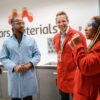By Taimur Khan, Special to Gulf News
March 20, 2018
It is an additional incentive for forward-looking businesses to attract top-draw talent as they use this as an opportunity to reshape their organisations, as they look to access innovative ideas
The move to a new office is increasingly being used to drive a wider process of business transformation.
There was once a time where firms looked to have the largest office space in the most prestigious areas, to attract and occasionally retain the best talent. Additionally, when firms looked to develop a global profile they tended to replicate the same strategy.
As the way of doing business has changed due to technology and evolving work habits and the definition of best-in-class office space has changed, businesses are having to rethink this strategy. More so they are using this as an opportunity to reshape their organisations, as they look to access innovative ideas, and the talent pools generating such ideas.
Therefore, the days when the office was viewed by businesses as simply a container in which to place people are long gone. Today, the office has become a mechanism through which wider strategic objectives can be advanced. Consequently, the relocation process has a lot hinging on it.
In reviewing the key leasing transactions that have taken place in global cities over recent years, it is abundantly clear that the majority of deals are indeed underpinned by one or more of the five broader strategic considerations.
A case in point is the recent reconfiguration of the Australian offices of KPMG. These moves saw the Big Four professional services firm commit to over 300,000 square feet. in Tower 3 at the International Towers Complex in Sydney’s new Barangaroo district, and to a similar amount of tower space at Collins Square near Melbourne’s Southern Cross Station.
KPMG realised that a relocation into a new space presented a tremendous opportunity to reset the business away from a “conservative” image towards one that was more innovative and progressive. In short, an image that was aspirational to the next generation of KMPG people; but which also excited and empowered the existing workforce, whose average age is just 28.
It was also a move that illustrated to clients that KPMG was a business that created innovative solutions and services, via a collaborative ethos. In this sense, the internal configuration and fitout of the space was as important as the modern, cutting-edge exteriors of the buildings.
Associated with the relocations therefore was a corporate mission to create the workplace of the future — space that is productive through the application of technology; that enables collaboration between employees by encouraging agility; and space which perpetuates a true sense of community. The total space taken by KPMG across the two cities has actually reduced — something that clearly supports the inevitable financial considerations of occupation.








